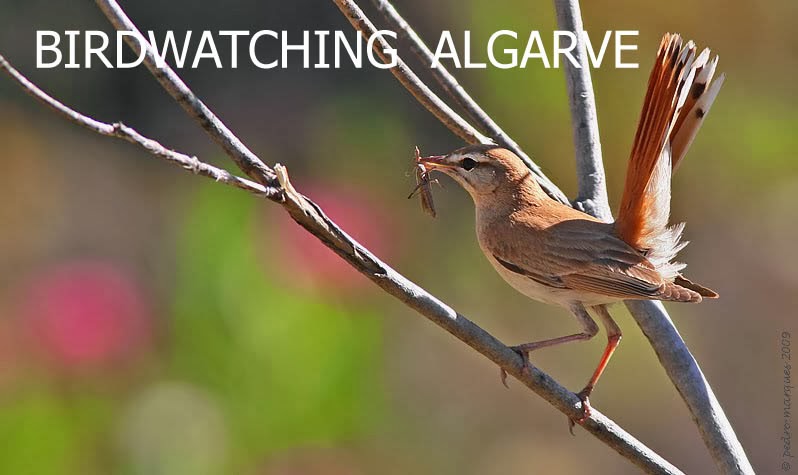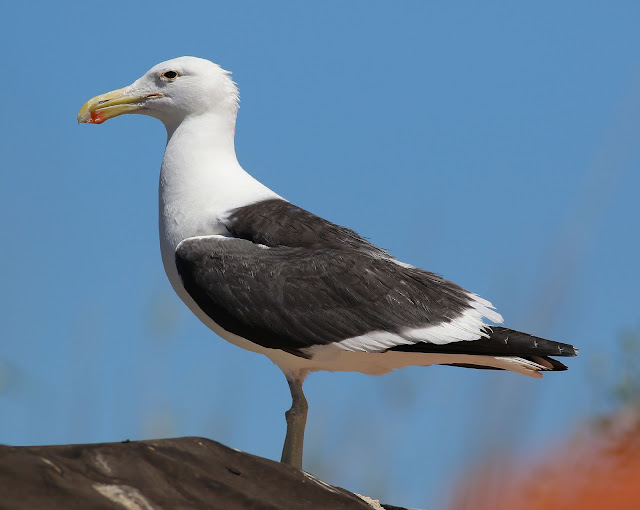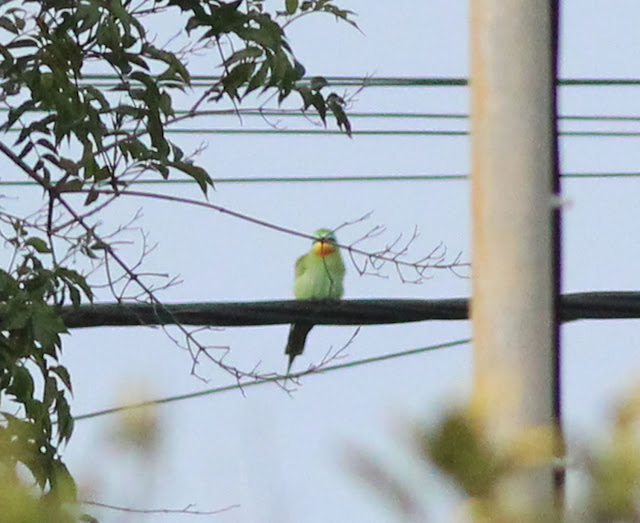Kelp Gull (Larus domincanus) is a southern hemisphere gull and breeds during the north winter, coastal mostly, in Southern Africa, South America, Antarctica, South Australia and New Zealand. It is a very rare vagrant to the Western Palearctic (Morocco mainly).
This bird here was found by Thijs Falkenburg on July, 5th in Olhão ("Quinta do Marim"). It belongs to the subspecies L.d. vetula ("Cape Gull") which breeds in Southern Africa. Cape Gulls are the largest among this species and they are particularly long-legged like this bird. Also the olive-green tinge to the leggs is typical, the crown is flat and the bill is heavy with a deep gonys angle, all together being jizz-wise much closer to a Greater black-backed Gull (Larus marinus) than to the also very dark-backed nominate form of Lesser-black-backed Gull (Larus fuscus fuscus), especially when dealing with an adult male, like in this case. An (older) article on Kelp Gull ID is here.
A curiosity is, that Thijs also found the first Kelp Gull for the Algarve (on 14-Aug-2013) only a few kms further west, at sewage works (ETAR) between Faro and Olhão (possibly the same bird?). Now this time this Kelp Gull showed up right at his work place, the recovery centre for injured birds and other wildlife (RIAS) in "Quinta do Marim", Olhão, sitting upon the cages containing chicks of Yellow-legged Gulls (Larus michahellis) and showing up there daily since about one week now. This is where I took these photos this morning (11-July-2016). So far this bird is the 5th record for Portugal.
Monday, July 11, 2016
Wednesday, July 6, 2016
Pelagic off Olhão
 |
| (all photos are clickable to enhance) |
 |
| Great Shearwater (Ardenna gravis) with Cory's Shearwaters (Calonectris borealis) off Culatra Island, 05-Jul-2016. |
For more than one hour we were basically surrounded by a huge pod of over 100 Short-beaked Common Dolphins (Delphinus delphis) and also well over 100 Cory's Shearwaters (Calonectris borealis) among which we coud also identify and photograph at least three Scopoli's Shearwaters (Calonectris diomedea) a species (or still a subspecies, depending on systematic - but have a look here). There are only a hand full of records of this taxon in the Algarve so far anyhow and as far as I know none of them documented by photos. On the other hand, Scopoli's mainly breeds in the Mediterranean and winters in the South Atlantic, so occurance in Algarvian waters during non-breeding season at least makes sense. Identification in the field is often not straight forward (good views or better, photos of the underwing neccessary) and therefore the few Scopoli's among the majority of Cory's go easily unidentified.
 |
| Scopoli's Shearwater (Calonectris diomedea) off Culatra Island (Olhão) 05-Jul-2016. Note the white extending into the wing tip (web of primaries). |
After searching for quite a while, we also spotted two Sooty Shearwaters (Ardenna griseus) and finally a single Great Shearwater (Ardenna gravis) - both giving great and close views and this is only the very beginning of the season for both species.
 |
| Great Shearwater (Ardenna gravis) with Cory's Shearwater (Calonectris borealis) in the background. Off Culatra Island, 05-Jul-2016. |
 |
| Cory's Shearwater (Calonectris borealis). Off Culatra Island, 05-Jul-2016. |
We also encountered Storm Petrels, among them Wilson's SP and European SP - perhaps three or four Ind. of each species, but did not get the best views, because without the birds foraging (next to a fishing boat pulling in the net, for instance) but only travelling, even photographing them is not an easy task. However, we managed at least record shots and thought to have found also one "Band-rumped Storm Petrel". The now potentially 4 species in this species-complex (compare Robb et al., 2008) were previously all lumped as Madeiran Storm Petrel (Oceanodroma castro or Hydrobates castro). Systematic here is not uniform and field-ID within the "Band-rumped SP -complex" is very difficult if not impossible, but have a look here). Interesting is that also the recently published "Atlas of Marine birds in Portugal" (in Portuguese) shows the occurence of this species in Algarvian waters.
However, after reviewing the ID and getting expert opinions, it turned out to be "just" a Wilson's SP flying with feet retracted and therefore completely lacking feet projection over the tail, one of the most usefull fetaures to ID Wilson's in the field. The Storm Petrel in question also shows a too short arm and too weak bill to be a possible "Band-rumped". We will keep looking....
 |
| Wilson's Storm Petrel (Oceanites oceanicus) off Culatra Island (Olhão) 05-Jul-2016. |
The following five photos show a potential "Band-rumped Storm Petrel" we saw during the trip. But for the reasons explained above, it turned out to be another Wilson's Storm Petrel in the end.
Expert opinion on the above Storm Petrel by Bob Flood is here:
In my opinion, this is a Wilson's Storm-petrel.
It has a small squarish head and slim bill (Band-rumped has bulkier
head and deeper bill, even the smaller forms). The arms are short and
broad, hands medium length, and wing tips pointed (Band-rumps have
medium-length arms, long hands, while some forms do have fairly pointed
wing tips). The leading edge of the wing is moderately angular, but the
trailing edge is fairly straight in most shots (typically angular in
Band-rumps). I don't think the tail is really forked; this may be an
impression given by a toe projection. It has a long caudal projection
(rear carriage behind wing, longer than Band-rumps). The head, body and
tail are fairly sleek (unlike Band-rumps). The white 'rump patch' folds
over to the underside and joins the thigh patches (depth greater than N
Atlantic Band-rumps). The upperwing ulnar bars are variable in intensity
in Wilson's and we see quite a few with dullish bars, as this bird
(affected by wear and bleaching). Second-year and older Wilson's start
moult by early June, but juveniles do not start the complete
preformative moult until at least mid July, most later, so presumably
this is a juvenile (plumage looks pretty fresh). By the way, it always helps if you describe flight behaviour, because this can be very important in storm-petrel ID.
Hope this is of use.
Cheers,
Bob
Robert L. Flood DSc, PhD, BSc (1st Hons)
www.scillypelagics.com
www.scillypelagics.com
Twitter: @Scillypelagics
Naturally we saw many Northern Gannets and also had one immature Pomarine Skua (Stercorarius pomarinus) flying over.
New dates for Pelagics have been scheduled on my website here. Available dates are: July, 22nd; August, 2nd; August 12th; August 25th; September 6th; September 30th; October, 13th. We can organize a pelagic at any time between June and October/November when the participation of min. 4 people is assured.
 |
| Pomarine Skua (Stercorarius pomarinus) pale morph juvenile flying over. C. 3 miles off Culatra Island, 5th of July 2016. |
 |
| And the Caspian Tern (Hydroprogne caspia) turned out to be color-ringed. Red: FY2. Still looking for the program... |
Tuesday, April 26, 2016
Blue-cheeked Bee-eater in the Algarve
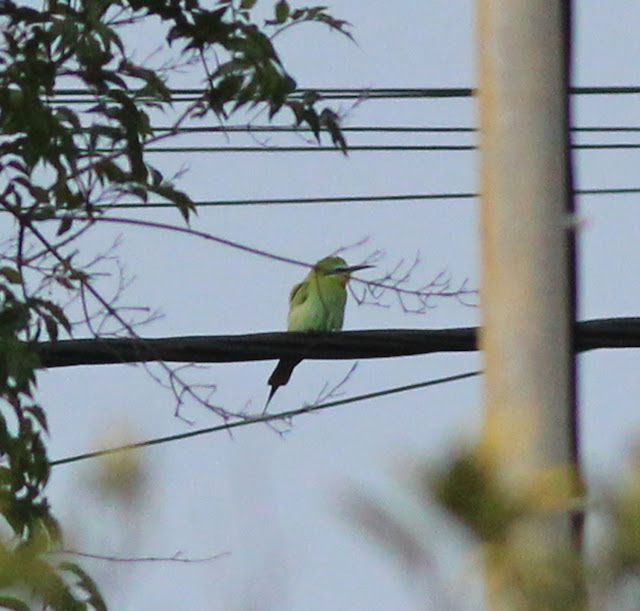 |
| Blue-cheeked Bee-eater / Abelharuco-persa / Blauwangenspint (Merops persicus) in Fuzeta-saltpans (Algarve) on April 18th, 2016. Foto: Georg Schreier. This is only the 2nd record for Portugal. |
The following search for the flock that have seemed to move on eastwards, following the coast line and stopping over in suitable habitat from time to time, for feeding, did not produce any result.
So I remained the one lucky guy, who was able to get a photo of this bird and the only one, who saw it after the finder.
Earlier that day, Western Orphean Warbler (Sylvia hortensis) and Melodious Warbler (Hippolais polyglotta) both near my home near São Brâs de Alportel, had been new birds for this year for me. The rather wet and windy April so far had not been great for spring migrants and birds arrived rather late. But some strong southwesterlies were responsible for bringing this "green jewel" into these parts, overshooting on its spring migration to its northernmost breeding grounds in Marokko supposedly. A good candidate for the bird of the year!
 |
| European Bee-eaters (Merops apiaster) at the same site. The "carrier species". |
http://www.birdwatching-algarve.com/pelagic-boat-trips.html
Monday, March 28, 2016
Spring migrants keep arriving
 |
| Male Marsh Harrier (Circus aeruginosus) over its breeding territory in a reed bed in Portimão-area on 26-03-2016. |
 |
| Male Great Bustards (Otis tarda) in the "pseudosteppe" of the Baixo Alentejo-region in Castro Verde-area. I took this photo out of the car during a tour in the region on March 9th, 2016. |
 |
| Regarding rarities over the past weeks in the Algarve, this first winter Bonaparte's Gull (Croicocephalus philadelphia) I found at Lagoa dos Salgados (Silves) on March 19th, 2016 has been one of the most interesting birds. Might be overlooked among Black-headed Gulls, but note the more delicate and blackish bill and grey head- and necksides, as well as light pinkish legs on this digiscoping shot I took on a second visit at the site on March, 26th. Other rarities included an adult male Citrine Wagtail, also near Lagoa dos Salgados. Unfortunately the information about the presence of this very rare vagrant to Portugal (3 records so far) had been passed on after days only and the bird was gone before it was made public... the male Bufflehead is still present at "Altura-reservoir" (near Monte Gordo) as today. |
 |
| Another record shot of the same bird as above -first winter Bonaparte's Gull (Croicocephalus philadelphia) in flight (the bird below) - note the all white underwing with dark trailing edge and compare to the underwing (primaries) of a Black-headed Gull Croicocephalus ridibundus. Feeding action of Bonaparte's Gull also resembling a Marsh Tern Sp. / Little Gullat times. (Video: click here ). |
Friday, February 12, 2016
Scotish Osprey, Short-eared Owl and Snow Finch
 |
| Short-eared Owl (Asio flammeus) in Ria Formosa Natural Park, near Faro-airport, 22-Jan-2016. I had a close encounter with this bird just before sunset... |
 |
| Female Cirl Bunting (Emberiza cirlus) near Aljezur, 01-Feb-2016. This species is mainly found in the western Algarve, at the west coast and around Monchique. |
Friday, January 8, 2016
Happy new year 2016 !
... and peace and health to all of you.
I include here a couple of photos - all taken on a tour during the week before Christmas 2015 - most photos showing typical species found up in the Baixo Alentejo plains.
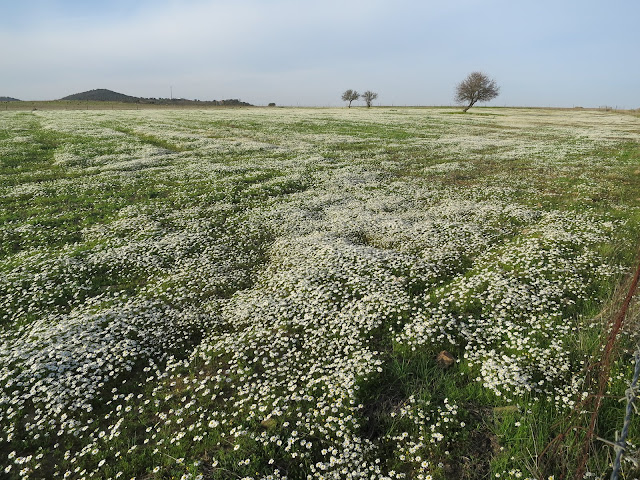
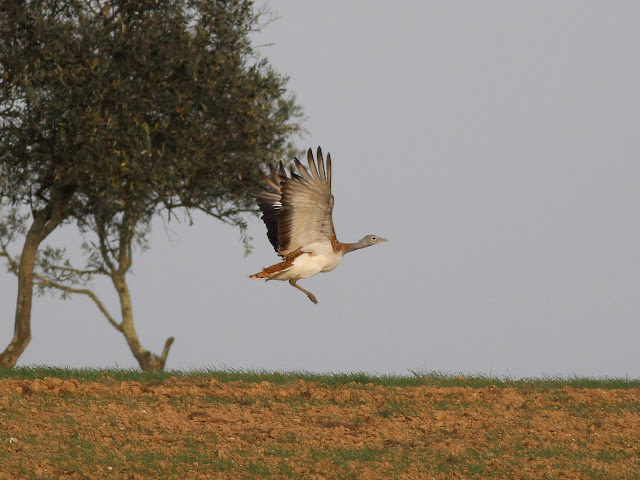
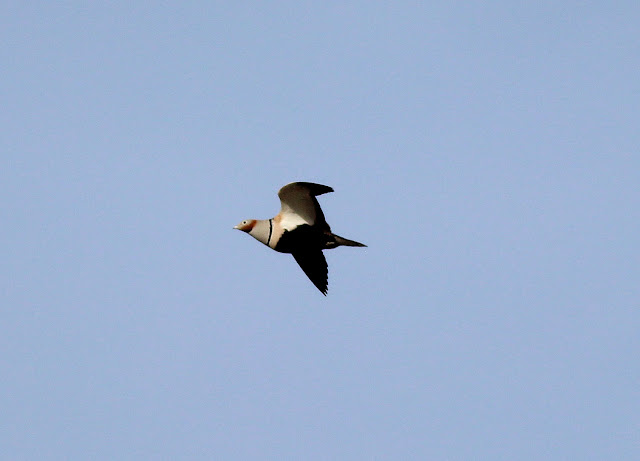


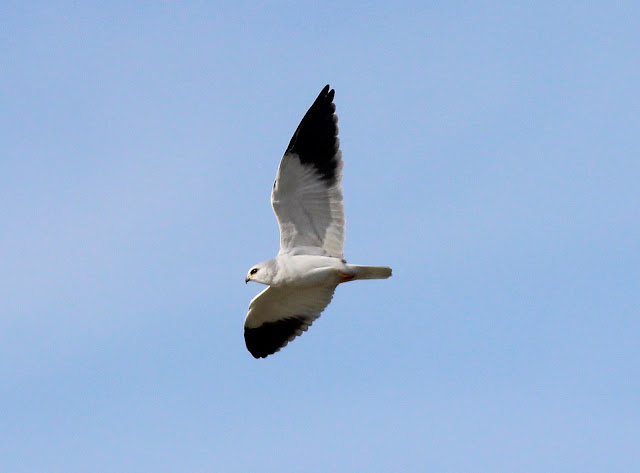
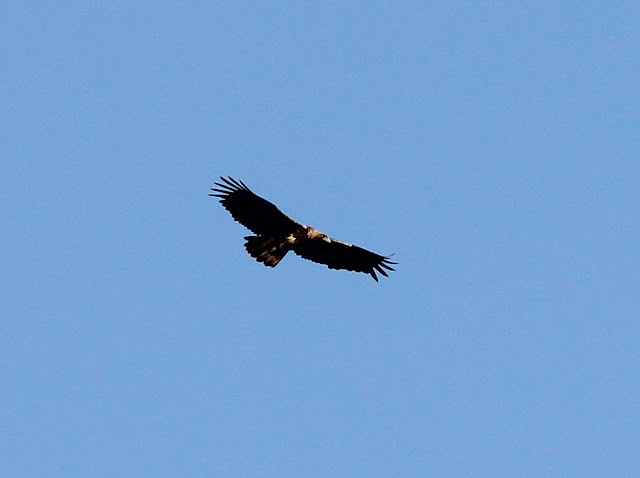
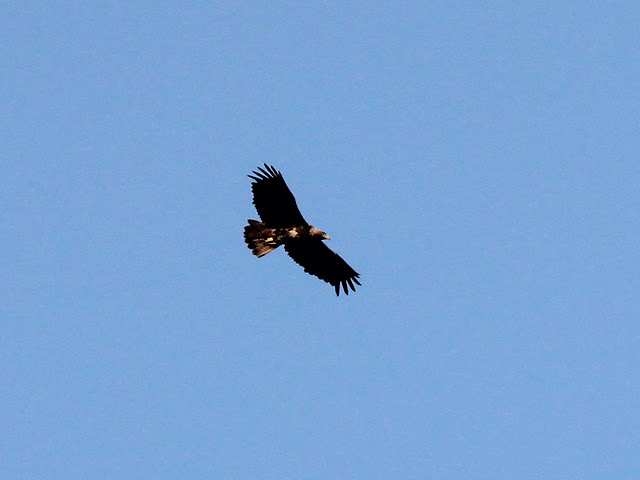

Regarding rarities - I "co-found" a first winter Glaucous Gull (Larus hyperboreus) on December, 18th in Sagres harbor and another one near Portimão, in the small harbor-bay of Ferragudo on December, 27th. Both birds practically still in juvenile plumage. There was (and probably still is today) also a Rock Pipit (Anthus petrosus) and an unusual obliging Shag. A Richard's Pipit (Anthus richardi) was on December, 19th in the fields west of Lagoa dos Salgados (Silves) where I found wintering birds in years before. a pair of Ring-necked Ducks (Aythya collaris) has been on a sewage work near Vilamoura for a couple of weeks in December, but seems to have gone now. A female or first winter Bufflehead (Bucephala albeola), another vagrant Duck species from North America has been found by June Taylor and Peter Dedicoat at a small lake near Aldeia Nova (Monte Gordo) in the pine forest of "Mata Nacional" on January, 3rd 2016. I relocated the (very nervous) bird the next morning on the nearby tank (east) of Altura. Curently it seems to frequently exchange places between this two sites. Also rather unusual - a Great (White) Egret in Ludo still on January, 1st.

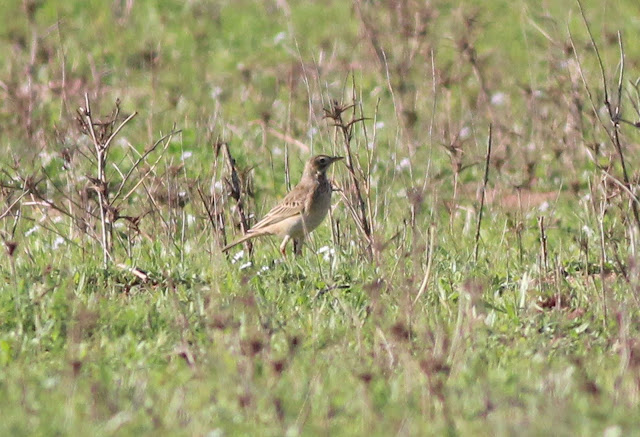
To be continued...
I include here a couple of photos - all taken on a tour during the week before Christmas 2015 - most photos showing typical species found up in the Baixo Alentejo plains.








Regarding rarities - I "co-found" a first winter Glaucous Gull (Larus hyperboreus) on December, 18th in Sagres harbor and another one near Portimão, in the small harbor-bay of Ferragudo on December, 27th. Both birds practically still in juvenile plumage. There was (and probably still is today) also a Rock Pipit (Anthus petrosus) and an unusual obliging Shag. A Richard's Pipit (Anthus richardi) was on December, 19th in the fields west of Lagoa dos Salgados (Silves) where I found wintering birds in years before. a pair of Ring-necked Ducks (Aythya collaris) has been on a sewage work near Vilamoura for a couple of weeks in December, but seems to have gone now. A female or first winter Bufflehead (Bucephala albeola), another vagrant Duck species from North America has been found by June Taylor and Peter Dedicoat at a small lake near Aldeia Nova (Monte Gordo) in the pine forest of "Mata Nacional" on January, 3rd 2016. I relocated the (very nervous) bird the next morning on the nearby tank (east) of Altura. Curently it seems to frequently exchange places between this two sites. Also rather unusual - a Great (White) Egret in Ludo still on January, 1st.


To be continued...
Subscribe to:
Posts (Atom)
